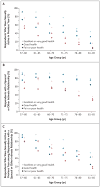A study of sexuality and health among older adults in the United States
- PMID: 17715410
- PMCID: PMC2426743
- DOI: 10.1056/NEJMoa067423
A study of sexuality and health among older adults in the United States
Abstract
Background: Despite the aging of the population, little is known about the sexual behaviors and sexual function of older people.
Methods: We report the prevalence of sexual activity, behaviors, and problems in a national probability sample of 3005 U.S. adults (1550 women and 1455 men) 57 to 85 years of age, and we describe the association of these variables with age and health status.
Results: The unweighted survey response rate for this probability sample was 74.8%, and the weighted response rate was 75.5%. The prevalence of sexual activity declined with age (73% among respondents who were 57 to 64 years of age, 53% among respondents who were 65 to 74 years of age, and 26% among respondents who were 75 to 85 years of age); women were significantly less likely than men at all ages to report sexual activity. Among respondents who were sexually active, about half of both men and women reported at least one bothersome sexual problem. The most prevalent sexual problems among women were low desire (43%), difficulty with vaginal lubrication (39%), and inability to climax (34%). Among men, the most prevalent sexual problems were erectile difficulties (37%). Fourteen percent of all men reported using medication or supplements to improve sexual function. Men and women who rated their health as being poor were less likely to be sexually active and, among respondents who were sexually active, were more likely to report sexual problems. A total of 38% of men and 22% of women reported having discussed sex with a physician since the age of 50 years.
Conclusions: Many older adults are sexually active. Women are less likely than men to have a spousal or other intimate relationship and to be sexually active. Sexual problems are frequent among older adults, but these problems are infrequently discussed with physicians.
Copyright 2007 Massachusetts Medical Society.
Figures

Comment in
-
Sex and aging.N Engl J Med. 2007 Aug 23;357(8):820-2. doi: 10.1056/NEJMe078137. N Engl J Med. 2007. PMID: 17715416 No abstract available.
-
Sexuality and health among older adults in the United States.N Engl J Med. 2007 Dec 27;357(26):2732; author reply 2732-3. doi: 10.1056/NEJMc072743. N Engl J Med. 2007. PMID: 18160696 No abstract available.
-
Sexuality and health among older adults in the United States.N Engl J Med. 2007 Dec 27;357(26):2732; author reply 2732-3. N Engl J Med. 2007. PMID: 18165976 No abstract available.
References
-
- Laumann EO, Nicolosi A, Glasser DB, et al. Sexual problems among women and men aged 40–80 y: prevalence and correlates identified in the Global Study of Sexual Attitudes and Behaviors. Int J Impot Res. 2005;17:39–57. - PubMed
-
- AARP/Modern Maturity sexuality survey. Washington, DC: National Family Opinion (NFO) Research; 1999.
-
- Schover LR. Sexual problems in chronic illness. In: Leiblum SR, Rosen RC, editors. Principles and practice of sex therapy. New York: Guilford; 2000. pp. 398–422.
Publication types
MeSH terms
Grants and funding
LinkOut - more resources
Full Text Sources
Other Literature Sources
Medical
